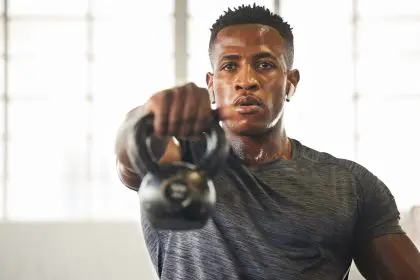How to determine which workout style will best help you reach your fitness goals
Most fitness enthusiasts have heard the terms “strength training” and “power training” tossed around in gym conversations, but many don’t fully grasp how these training methods differ or which one might better serve their personal goals. Despite their similar-sounding names, these two training approaches lead to distinctly different physical adaptations and outcomes. Understanding these differences can transform your workout routine and help you achieve your desired results more efficiently.
What sets strength and power training apart
At their core, strength and power training target different aspects of muscle performance. Strength training focuses primarily on building raw muscle force—your ability to move heavy loads regardless of speed. This training style enhances your capacity to lift heavier weights and increases muscle size over time.
Power training, on the other hand, emphasizes explosive force development—how quickly you can generate force. This quality combines strength with velocity, focusing on moving weights with speed rather than simply moving heavier loads. While strength is about what you can lift, power is about how fast you can lift it.
The distinction becomes apparent in practical examples: A powerlifter performing a maximum deadlift demonstrates pure strength, while a basketball player executing a vertical jump displays power. Both qualities serve different functional purposes in both athletic performance and everyday life.
The science of strength development
Strength training works through progressive overload—gradually increasing the resistance your muscles work against to stimulate adaptation. This process causes microscopic damage to muscle fibers, which then repair and rebuild stronger than before.
The most effective strength training programs typically feature:
Traditional compound movements such as squats, deadlifts, bench presses, and rows that engage multiple muscle groups simultaneously. These exercises create efficient strength gains across the body rather than isolating individual muscles.
Heavier weights relative to your capacity, generally around 70-90% of your one-rep maximum. This intensity range optimally stimulates muscle growth and strength adaptation without excessive fatigue or injury risk.
Slower, controlled movement tempos that emphasize proper form throughout each repetition. This approach maximizes muscle fiber recruitment and minimizes momentum that could reduce effectiveness.
Moderate repetition ranges, typically 6-12 repetitions per set for 2-6 sets, with substantial rest periods of 2-4 minutes between sets. This structure allows for sufficient intensity while managing fatigue.
Weekly progression through either increased weight, additional repetitions, or more sets to ensure continued adaptation. Without progression, the body quickly adapts to a given stimulus and improvements plateau.
The mechanics of power development
Power training employs different mechanics to develop explosive capacity. Rather than focusing solely on the amount of weight moved, power training emphasizes the speed of movement and rate of force production.
Effective power training typically involves:
Explosive movements such as jump squats, box jumps, medicine ball throws, and Olympic lifting variations that develop coordinated force production throughout the entire body. These movements require rapid acceleration and deceleration.
Lighter loads moved at maximal velocity, usually around 30-60% of your one-rep maximum. This moderate resistance allows for optimal power output without compromising movement speed.
Emphasis on acceleration rather than constant tension, with powerful concentric (shortening) phases followed by controlled eccentric (lengthening) phases. This pattern trains the neuromuscular system to rapidly recruit muscle fibers.
Lower repetition schemes of 1-5 reps per set for 3-5 sets, with longer rest periods of 2-3 minutes to ensure quality remains high throughout the workout. Fatigue quickly diminishes power output, making quality more important than quantity.
Technical precision in movement patterns to maximize efficiency and prevent injury during explosive exercises. As complexity increases, proper coaching becomes increasingly valuable.
Real-world benefits of strength training
Strength training offers numerous practical advantages that extend well beyond the gym environment:
Enhanced functional movement capacity for everyday tasks, from carrying groceries to moving furniture or lifting children. This improved capability reduces injury risk during daily activities and supports long-term independence.
Preservation of lean muscle mass, which becomes increasingly important after age 30 when people typically begin losing 3-5% of muscle per decade without resistance training. This retention helps maintain metabolism and body composition.
Increased bone mineral density through the mechanical stress placed on the skeletal system during resistance training. This adaptation reduces osteoporosis risk, particularly important for women after menopause.
Improved metabolic health including better insulin sensitivity, glucose regulation, and cholesterol profiles, which help manage or prevent conditions like type 2 diabetes and cardiovascular disease.
Enhanced body composition through increased muscle mass and potential fat loss, leading to improved aesthetic outcomes for those with physique-related goals.
Reduced chronic pain, particularly in the lower back, knees, and shoulders, by strengthening supportive musculature and correcting imbalances that contribute to discomfort.
Practical advantages of power training
Power training provides its own unique set of benefits that complement or sometimes exceed those of traditional strength training:
Improved reaction time and neuromuscular coordination that enhance performance in sports and daily activities requiring quick responses, from catching a falling object to regaining balance after a stumble.
Enhanced athletic performance across various sports through improved acceleration, jumping ability, and explosive movements. Even recreational athletes notice significant functional improvements.
Greater caloric expenditure during workouts due to the higher intensity and full-body nature of power movements, potentially supporting weight management goals.
Preservation of fast-twitch muscle fibers which naturally decline with age but remain crucial for rapid force production in emergency situations.
Maintenance of independence in older adults by preserving the ability to quickly recover from balance perturbations and generate force rapidly when needed, such as when climbing stairs or standing from a seated position.
Increased muscle fiber recruitment and neuromuscular efficiency, leading to greater strength gains when combined with traditional strength training approaches.
Who benefits most from strength training
Certain populations may find strength training particularly advantageous:
Individuals focused on muscle hypertrophy (size increases) will benefit significantly from strength training’s ability to create muscle tension and metabolic stress, key factors in muscle growth.
People recovering from injuries often need to rebuild basic strength before progressing to more dynamic movements. Controlled strength training provides a safe foundation for rehabilitation.
Older adults looking to maintain independence and functional capacity benefit tremendously from strength training’s ability to preserve muscle mass and function during aging.
Those with sedentary occupations who need to counteract the negative effects of prolonged sitting can restore muscle balance and posture through strategically planned strength work.
Individuals with aesthetic goals focused on muscle definition and shape will find strength training essential for building the foundation of their desired physique.
Who thrives with power training
Power training particularly benefits:
Athletic competitors in sports requiring explosive movements such as basketball, volleyball, football, and track and field events. These activities directly transfer the adaptations from power training.
Active adults who enjoy recreational sports or activities requiring bursts of speed or quick directional changes will notice significant performance improvements.
Fitness enthusiasts seeking variety and challenge beyond traditional strength routines often find power training mentally engaging and physically stimulating.
Adults in their 40s and beyond looking to maintain fast-twitch muscle fibers and movement speed that naturally decline with age can significantly slow this decline with appropriate power work.
Individuals who have established a strength base and are looking to enhance their functional fitness in real-world scenarios that rarely require slow, controlled movements.
Creating your optimal training balance
Rather than viewing strength and power training as mutually exclusive, consider how these modalities might complement each other in your fitness regimen:
For beginners, establishing fundamental strength and movement patterns should take priority before introducing explosive movements. This foundation ensures safety and effectiveness when power training is eventually incorporated.
Intermediate fitness enthusiasts can benefit from a balanced approach that might include 2-3 strength-focused sessions and 1-2 power-focused workouts weekly, creating well-rounded physical capabilities.
Advanced trainees might consider periodizing their training, spending dedicated blocks focusing predominantly on either strength or power before switching emphasis to continue progress in both qualities.
A practical approach for many involves beginning workouts with power-based movements when the nervous system is fresh, followed by strength-focused work to complete the session. This structure optimizes both qualities without requiring separate workouts.
Consider your primary goals when allocating training time. Those primarily concerned with functional longevity might emphasize strength work with power training as supplementary, while athletes might reverse this emphasis depending on their sport’s requirements.
Sample balanced training week
A well-designed program incorporating both training styles might look like this:
Monday: Lower body strength focus (squats, Romanian deadlifts, leg press)
Tuesday: Upper body power focus (medicine ball chest throws, plyometric push-ups, explosive rows)
Wednesday: Active recovery or cardio
Thursday: Full body strength focus (deadlifts, overhead press, pull-ups, core work)
Friday: Lower body power focus (jump variations, kettlebell swings, sprints)
Saturday: Upper body strength focus (bench press, rows, shoulder work)
Sunday: Complete rest or light activity
This structure creates a balance between both training styles while allowing sufficient recovery between similar movement patterns.
Making your final decision
When determining your personal training focus, consider these guiding questions:
What are your primary goals? Muscle size and strength gains favor traditional strength training, while athletic performance improvements might benefit more from power work.
What activities do you enjoy in daily life? Your training should enhance rather than detract from the physical activities that bring you joy outside the gym.
What is your injury history and current physical condition? Those with certain orthopedic issues might need to emphasize controlled strength work before introducing impact-based power training.
What equipment and facilities are available to you? While strength training can be accomplished with basic weights, some power movements benefit from specialized equipment like plyo boxes or Olympic lifting platforms.
How much time can you realistically commit? A combined approach requires more training time than focusing exclusively on either quality, so time constraints may necessitate prioritization.
Remember that the most effective fitness program is ultimately the one you’ll perform consistently. Choose the approach that not only aligns with your goals but also keeps you engaged and motivated for the long term.













